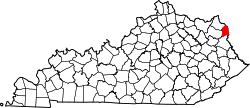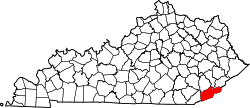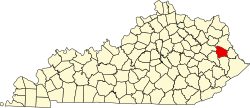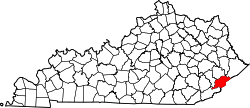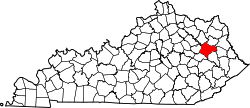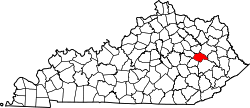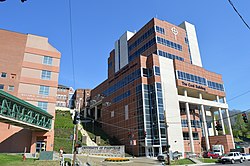



The Eastern Kentucky Coalfield is part of the Central Appalachian bituminous coalfield, including all or parts of 30 Kentucky counties and adjoining areas in Ohio, West Virginia, Virginia, and Tennessee. [3] It covers an area from the Allegheny Mountains in the east across the Cumberland Plateau to the Pottsville Escarpment in the west. The region is known for its coal mining; most family farms in the region have disappeared since the introduction of surface mining in the 1940s and 1950s.
Contents
- Geography
- Counties
- Major cities
- Protected areas
- Historical parks
- State resort parks
- State recreational parks
- Other
- Economy
- Persistent poverty
- Appalachian Regional Commission
- Health
- Post-secondary education
- Public universities
- Private colleges and universities
- Community and technical colleges
- Political climate
- Notable people
- See also
- References
- Further reading
- External links
The Daniel Boone National Forest is located on rough but beautiful[ citation needed ] terrain along and east of the Pottsville Escarpment. There are many natural arches and sandstone cliffs that are excellent for rock climbing and rappeling.[ citation needed ] The Red River Gorge, part of the National Forest, is known worldwide in rock climbing circles. [4]
The Sheltowee Trace Trail runs 260–270 mi (420–430 km) north and south, through the region.
During the American Civil War most of this region leaned toward the Union due to its makeup at the time of mostly small farmers, but more than 2,000 men from this area formed the 5th. Kentucky Vol. Inf., known as the Army of Eastern Kentucky, under Gen. Humphrey Marshall, C.S.A. During the Great Depression, New Deal programs and the organizing of the United Mine Workers of America made many of the eastern counties Democratic. The region was the childhood residence of Vice President JD Vance, who was primarily raised in Jackson, Kentucky.
Eastern Kentucky has a rich musical heritage. Many nationally acclaimed country music singers and musicians are from the area. These include: Loretta Lynn, Crystal Gayle, The Judds, Ricky Skaggs, Keith Whitley, Patty Loveless, Dwight Yoakam, Tom T. Hall, Billy Ray Cyrus, Jean Ritchie, Sturgill Simpson, Tyler Childers, Chris Stapleton, and George S. Davis.
As of the 1980s, the only counties in the United States where over half of the population cited "English" as their only ancestry group were in the hills of eastern Kentucky (and made up nearly every county in this region). [5] In the 1980 census, 1,267,079 Kentuckians out of a total population of 2,554,359 cited that they were of English ancestry, making them 49 percent of the state at that time. Large numbers of people of Scottish and Irish ancestry settled the area as well. [6]

